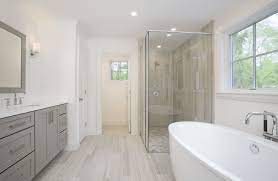When it comes to bathroom design, the shower is often a focal point that receives careful attention. While practical considerations like tiles and fixtures are essential, the inclusion of crown molding in bathroom showers has emerged as a trend that elevates the space to a new level of sophistication. In this article, we will explore the benefits, considerations, and design possibilities associated with incorporating crown molding into your bathroom shower.
1. Definition and Purpose:
Crown molding, traditionally used to add a decorative touch to the junction of walls and ceilings, is finding its way into unexpected spaces, including bathroom showers. In the shower context, crown molding serves both a functional and aesthetic purpose. It not only adds an element of luxury and style but also helps protect the upper edges of the shower walls from moisture and potential damage.
2. Material Options:
Choosing the right material for shower crown molding is crucial, given the humid environment. Opt for materials that can withstand moisture and are resistant to mold and mildew. PVC, polyurethane, or composite materials are popular choices as they are durable, water-resistant, and available in a variety of styles that mimic the look of traditional wood molding without maintenance concerns.
3. Design Versatility:
Crown molding comes in a myriad of styles and designs, allowing for creative expression in bathroom decor. From simple and sleek profiles to more intricate and ornate patterns, there’s a crown molding style to suit every design aesthetic. Consider the overall theme of your bathroom and choose crown molding that complements existing elements, such as tiles, cabinetry, and fixtures.
4. Waterproofing Considerations:
Given the proximity to water and steam, ensuring proper waterproofing is essential when incorporating crown molding in bathroom showers. Apply a waterproof adhesive to securely attach the molding to the shower walls. Additionally, seal the seams and joints with a waterproof caulk to prevent water infiltration. Proper installation is crucial to maintaining the integrity of the crown molding in a moisture-rich environment.
5. Crown Molding Heights:
The height at which crown molding is installed in a bathroom shower is a crucial design decision. Traditionally, crown molding is positioned at the junction of walls and ceilings, but in showers, it can be installed lower for a more dramatic effect. Consider the height of your shower walls, the size of the tiles, and the overall design aesthetic when determining the ideal placement of crown molding.
6. Coordinating with Shower Tiles:
Coordinate the design of your crown molding with the tiles used in the shower to create a cohesive and harmonious look. Matching the color or finish of the molding to the tiles can tie the elements together while contrasting colors can create visual interest. Pay attention to the overall color palette of the bathroom to ensure a unified and well-balanced design.
7. Transitioning to Ceiling Molding:
If your bathroom features crown molding in other areas, consider extending the design into the shower for a seamless transition. This cohesive approach can create a sense of continuity and elevate the overall design of the bathroom. Ensure that the molding used in the shower is suitable for the unique conditions of this space.
8. Maintenance and Cleaning:
Crown molding in bathroom showers requires regular maintenance to ensure its longevity and appearance. Wipe down the molding regularly to prevent the buildup of soap scum, mold, or mildew. Use a mild cleanser and a soft cloth to clean the surface, avoiding harsh chemicals that could damage the material. Proper maintenance will help preserve the beauty of the crown molding over time.
9. Illuminating the Shower Space:
Crown molding can also serve a functional role in enhancing the lighting within the shower. Consider incorporating LED lighting into the crown molding for subtle and indirect illumination. This not only adds a touch of luxury but also contributes to a spa-like ambiance in the shower, creating a relaxing and inviting space.
10. Practical Benefits:
Beyond its decorative appeal, crown molding in bathroom showers offers practical benefits. It helps protect the upper edges of shower walls from water splashes, reducing the risk of water damage and deterioration. This added layer of protection can contribute to the longevity of the shower walls and surrounding materials.
11. Professional Installation:
While crown molding installation may seem like a manageable DIY project, enlisting the services of a professional can ensure a flawless and secure application. Professionals have the expertise to navigate potential challenges, such as uneven walls or corners, and can guide the best materials and styles for your specific bathroom.
12. Customization and Personalization:
Crown molding in bathroom showers allows for customization and personalization. Explore the possibility of incorporating unique design elements, such as built-in shelving or niche detailing, to enhance both the functionality and aesthetics of the shower space. Customized crown molding can add a signature touch to your bathroom design.
Conclusion:
Crown molding in bathroom showers represents a design innovation that brings an air of elegance and sophistication to this essential space. Beyond its aesthetic appeal, crown molding offers practical benefits and allows for creative expression in bathroom decor. Whether aiming for a classic, contemporary, or eclectic design, the inclusion of crown molding in your shower can transform the space into a luxurious retreat where style meets functionality.

